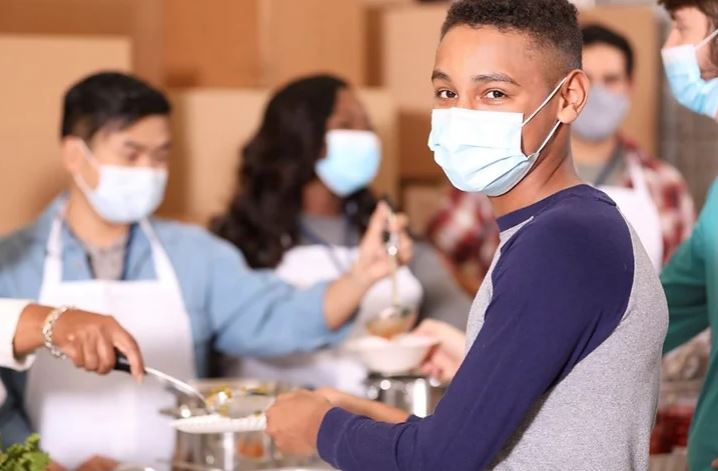Hunger & Homelessness: 7 Ways You Can Help
November 19, 2021

The week of Nov. 13-21, 2021, was Hunger and Homelessness Awareness Week – a targeted opportunity to learn more and raise awareness about the challenges and realities of families and individuals who experience hunger and homelessness. Last year in the U.S, an estimated 116.4 million people were reported to be food insecure, and 580,466 were reported homeless.
Although hunger and homelessness is a nationwide challenge, state lawmakers throughout the U.S are committed to finding solutions and resources to best support those struggling to access food and housing through policy, programs, and funding. Finding a solution to the crisis is no easy task and one that cannot be solved overnight.
The good news is that you can immediately impact the lives of those struggling with food insecurity and homelessness in and around your community, and here are seven ways to get you started.
Don’t waste food – donate it:
The U.S. Department of Agriculture estimates food waste to be 30 to 40 percent of the overall food supply. Even with this much food wasted, many households deal with food insecurity. In Colorado alone, 33 percent of Coloradans lack reliable access to nutritious food, according to Hunger Free Colorado. If we work together as a community to redirect food waste to feed those in need, we can make a difference in someone’s life today. Look in your kitchen regularly to see what food you and your family will not eat, either because of looming expiration dates or pure excess, and drop it off at a local food pantry. Pantries can be found in local schools, shelters, churches, mosques, or even in individuals’ homes. It’s a good idea to call your selected pantry ahead of time to confirm that they accept the food you’d like to donate.
Share local resources with those in need:
Familiarizing yourself with local shelters and food banks can make you a valuable resource to your community. With information about local resources, you can readily direct people to the supports they need, making access much easier for those who need them. You can even create and print a list of local resources to hand out to those who may benefit from them. Organizations and resources such as the RMHS Resource Page, 211 Colorado, or Findhelp.org can be used as tools to familiarize yourself with area shelters, food banks, support organizations, and more.
Volunteer your time at a local shelter or food bank:
Time is a valuable asset, especially when used to help others in less fortunate circumstances. Shelters and food banks welcome hands-on assistance and volunteers. Volunteering at local shelters and food banks can help strengthen the organizations that support those in need and the individuals who benefit from them. You can find shelters near you using the HUD Find Shelter online tool and local food banks by visiting the Foodbank of the Rockies for northern Colorado or Care and Share Foodbank for southern Colorado.
Donate items when you can:
Shelters and foodbanks work around the clock to house and feed people who do not have much, and certain supplies are essential to keeping those individuals healthy, fed, and clothed with seasonal items. To find out what items are most needed, call your local shelters and food banks and donate what you can. Commonly needed items include food, personal hygiene products, money, socks, jackets, and other clothing items.
Recruit Others to Help:
Having a community of support can be the differentiator between having little to no access to vital resources and changing the lives of those in need. Sharing your passion for helping others and encouraging community members to do the same helps expand your collective reach, connects individuals with needed resources, and improves your community overall. You can boost community engagement by organizing giveback initiatives, food and clothing drives, and volunteer opportunities in your area. You can also distribute information on local resources and encourage those around you to donate to the causes that they feel most connected to.
Mentor youth in local shelters:
In the U.S., approximately 30 percent of homeless individuals are under the age of 24. Homelessness is known to have a lasting effect on the lives of those who experience it, and it can be difficult for kids and young adults facing housing instability to connect with something positive and work toward their potential. If you want to make a difference in a young person’s life who is experiencing homelessness, you can volunteer your time as a mentor in local and area shelters. Volunteering as a mentor can significantly impact the direction of someone’s life and mean the difference between a life of instability and one with promise and hope. You can find youth shelters near you here.
Be kind:
Connecting people with the support they need can go a long way, but so can simple gestures of kindness. Mental health is a key indicator of hope, motivation, and success. Kind gestures such as taking time out of the day to exchange a few words or give a thoughtful gift to someone experiencing hunger or homelessness can help tremendously. Kind gestures can help lift the veil of social isolation and depression, which can feel paralyzing to those experiencing them. We are all people, and kindness can support the mental health of those struggling to meet basic needs. Friendly conversations, guidance, a smile, or small donation can go a long way.
Building awareness around the issue of hunger and homelessness in our communities and doing what we can to help is what makes life-changing impacts on the lives of those who need support. Every little bit helps.






